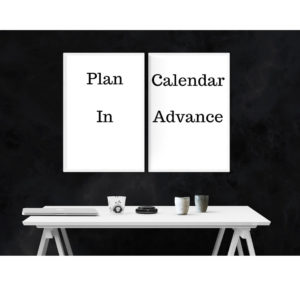Content Marketing Calendar
If you’re responsible for posting regular content—whether original, curated, or a mix of both—you know how challenging it can be to develop great content on a daily or weekly basis.
A content calendar is a helpful way to organize your content and ensure you’re posting a mix of information on your digital and social media marketing platforms.
If used consistently, it can be a key resource in your marketing plan. It’s a tool you can use to establish your position as an industry leader and show that you are in touch with your audience and their needs.
Following are five tips to help you utilize a content calendar as part of your overall content marketing strategy.
Use a Template
Whether you download a digital template (such as Google Calendar), key in the information on an old-fashioned Word document, or even hand-write the schedule on a paper calendar or whiteboard, it’s best to use a calendar tool so you can access your full posting schedule whenever you need to.
If you’re part of a marketing team responsible for content creation and posting, it’s best to use a digital template that allows access for more than one user. Create a master spreadsheet in Microsoft Excel or Google Sheets to track your ideas.
Mix Up Your Content
Your calendar should contain different types of content. Ideally, strive for both original (posts written by you and/or your colleagues) and curated (posts from others shared on your page) posts. Your content doesn’t have to be limited to social media marketing.
Think blog posts (both long- and short-form), email newsletters and periodic blasts for noteworthy announcements, podcasts, and videos.
General rules for social media are:
- Share content posted by others (posts you’ve commented on, not just shared)
- Post original content that’s not a blatant sales pitch (perhaps a tease about that new product you’re launching)
- Post original content that’s authentic and relevant to your business or overall industry (using the playground equipment manufacturer example, you can share a post talking about the importance of physical activity and playing outside to prevent childhood obesity).
By publishing content on various platforms, you’re engaging different readers (and hopefully future customers). It keeps the creative process fresh and interesting for you and your colleagues, too. Keep your posts relevant to your business or topic you’re discussing.
For instance, if you’re developing content for a playground equipment manufacturer, you probably wouldn’t share a post about the 10 best footwear styles for the beach this summer. You might, however, share a post from a children’s shoe manufacturer discussing the 10 best kids’ footwear styles for the playground.
Publish Regularly
Accountability is a big reason for using a content calendar. It keeps you on a consistent publishing schedule. Readers don’t want to find your blog and discover your last article was posted over a year ago. There are two key reasons for inconsistent posting: lack of time, and lack of content ideas.
Unfortunately, we’re all given the same 24 hours in a day. If your workload is preventing you from sticking to your content calendar, try to create a more workable posting schedule or share some of the content creation and posting responsibilities with a colleague.
If your well of ideas is drying up, it may be time to re-examine your posting strategy, if not your entire content plan. This is where hard data can be helpful, whether you use Google Analytics or another tracking method. The numbers will show you exactly where your readers are going and which pieces of content are most effective.
 Plan Calendar in Advance
Plan Calendar in Advance
Digital marketing experts’ opinions differ, but ideally, you should share content once a week at the absolute minimum. At the end of each month, sit with your team and work out the content calendar for the next month.
Embed your ongoing content projects first (such as your weekly or biweekly blog posts) so they are on the schedule immediately. Next, look at what is going on within your company. Are you launching new products or services or holding a special event on-site?
Add them to your calendar as soon as you have a firm date and work backward so your marketing is on track and you’re aware of due dates for relevant content.
Finally, be flexible with your calendar and allow room for last-minute scheduling changes or additions.
For instance: That new product you were expecting to roll out in two months is ready ahead of schedule and you must scrap your original social media posts for a certain week in order to announce the new product.
Or, your company won a prestigious industry award and the marketing team is tasked with getting the word out immediately. Time-sensitive company information always takes precedence over other content.
Schedule Content with Reader Engagement in Mind
Your content should always be created and scheduled focused on generating a high level of audience engagement. It should be both informative, fun, and welcome feedback.
What are the newest trends within your industry?
Share a few relevant posts or come up with your own and ask for readers’ thoughts. Look for upcoming fun or unusual holidays that you can promote and encourage readers to post comments or photos.
The feedback is useful in two ways: it starts an important dialogue with your audience, and it may provide ideas for future content. Even the most prolific content creator gets stuck for ideas occasionally.
When this happens, look through the comments you’ve received on past posts. And if you still have trouble coming up with content ideas, there are always lighthearted cat videos worth sharing.
A content calendar keeps your digital and traditional marketing timely and consistent. But like any other productivity tool, it only works if you use it regularly.




